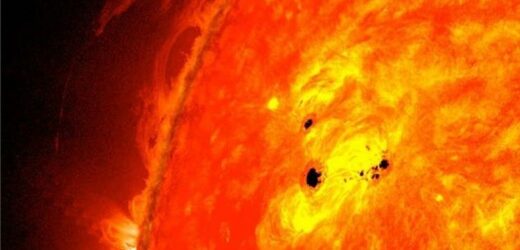Solar storm: NASA captures the moment a sunspot 'explodes'
When you subscribe we will use the information you provide to send you these newsletters. Sometimes they’ll include recommendations for other related newsletters or services we offer. Our Privacy Notice explains more about how we use your data, and your rights. You can unsubscribe at any time.
One of the “brightest and fastest” coronal mass ejections (CMEs) of the current solar cycle will swing past Earth on June 1. Although not expected to strike the planet head-on, space weather forecasters predict a glancing blow is still on the cards. CMEs are monstrous expulsions of plasma and magnetic lines that erupt from the solar corona – the Sun’s outer atmosphere.
According to the US space agency NASA, a large CME can contain billions of tonnes of material travelling at millions of miles per hour.
CMEs sometimes occur after the appearance of a solar flare, although the two are independent of each other.
The recent CME was photographed by spacecraft on May 28, escaping from the Sun on Friday, May 28.
According to the website SpaceWeather.com, the CME may now come close enough to Earth’s magnetic sphere to trigger a solar storm over the planet.
The website said: “Minor G1-class geomagnetic storms are possible on June 1 when a CME is expected to sideswipe Earth’s magnetic field.”
The CME was caught on camera by the Solar and Heliospheric Observatory spacecraft, “hurled into space” by the sunspot AR2824.
Sunspots, which are dark blotches on the Sun’s surface where the magnetic field causes temperatures to drop, can erupt into CMEs.
SpaceWeather added: “This is one of the brightest and fastest CMEs of new Solar Cycle 25.
Solar storm could cause ‘catastrophic damage’ to UK
“If it were heading directly toward Earth the forecast might be different, calling for major instead of minor geomagnetic storms.”
Luckily for us, the sunspot was not facing our planet directly.
Forecasters, therefore, only expect the tail end of the plasma cloud to strike the magnetosphere.
But the blow could be enough to trigger a minor, G1 geomagnetic or solar storm.
Scientists rank solar storms on a scale of G1 (Moderate) to G5 (Extreme).
The strongest storms can cause widespread tech blackouts, fry satellites and even cause damage to power grids.
G1 storms are barely noticeable but may still cause weak power grid fluctuations.
According to the US Space Weather Prediction Center (SWPC), “minor impact” on satellite operations is possible.
Some migratory animals at high latitudes are also known to be affected.
The most likely impact of the storm is the presence of auroras up north or south.
In the north, these are the Northern Lights of Aurora Borealis, while in the South the Southern Lights or Aurora Australis appear.
SpaceWeather said: “That said, even glancing blows from CMEs can produce a good light show.
“High-latitude sky watchers should be alert for auroras on June 1.”
Source: Read Full Article





